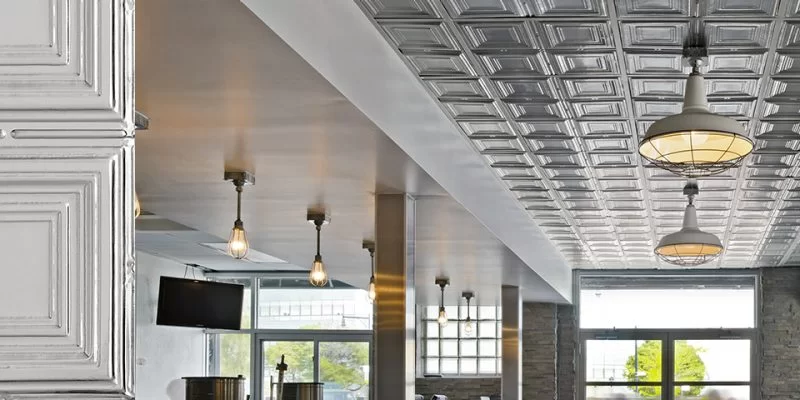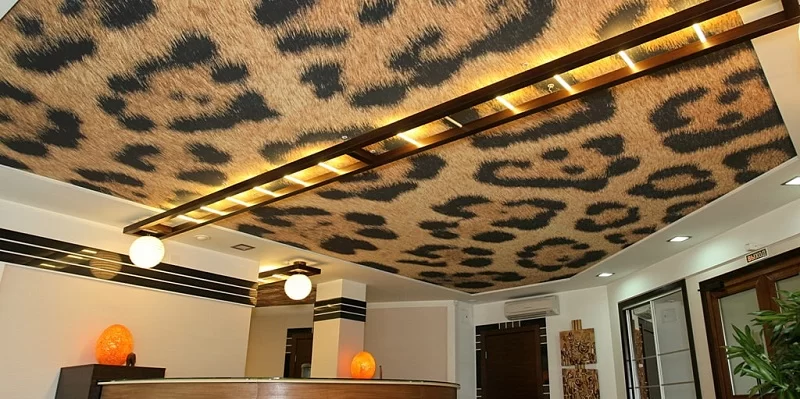
Compare fabric and PVC stretch ceilings
The fabric of stretch ceilings is made of two types of materials — PVC (polyvinyl chloride film) or polyester thread fabric (polyester canvas impregnated with polyurethane). Our experts in the field of construction and repair examined the properties and features of both materials, made a comparative analysis of their advantages and disadvantages, which will help you choose the right one.
PVC ceiling

PVC ceilings are made from canvases, which are obtained by passing the molten polyvinyl chloride mass through the rolls of a rolled thermal press. The width of the sheets obtained can be in the range from 1.3 to 2.2 m. In order to make membranes of greater width, the sheets are welded using high-frequency welding, so that the seams remain almost invisible.
The weight of the PVC web or film is only 180 to 320 g/m2, the thickness can be in the range of 0.15 to 0.35 mm, the tensile strength is up to 30 N — before the film is torn, it can be doubled. At room temperature, the PVC film retains the properties of elasticity and elasticity, however, when heated above 65 ° C, it can stretch, therefore, when installing built-in lamps, it is necessary to limit the power of the lamps and maintain normal temperature conditions during indoor operation. The film does not let water through and is able to withstand pressure up to 1000 Pa. Belongs to the group of slow-burning materials. It is sensitive to temperature changes — at temperatures below zero it becomes brittle, and when the temperature drops below 40 ° C, it begins to collapse, so PVC film ceilings cannot be used in unheated rooms.
The surface of the PVC membrane can be glossy, matte or look like a satin fabric. Manufacturers offer PVC film painted in more than 200 colors and shades, in addition, the surface can be mother-of-pearl, translucent, like tinted glass, images made using photo printing up to 3D graphics can be applied to it.
fabric ceiling

Fabric stretch ceiling fabric is made of canvas woven from polyester threads and impregnated with polyurethane composition, which gives it elasticity and dimensional stability. The width of the fabrics produced by manufacturers varies between 3 and 5 m, which makes it possible to install seamless ceilings in most rooms. If you want to install wider ceilings, then the canvases are connected using a special profile or simply sewn together.
Fabric ceilings do not differ in richness of colors, but they benefit from the textured surface, the possibility of applying a variety of patterns, and besides, fabric ceilings can be painted and repainted.
The weight of the fabric web is about 200 g/m2 with a thickness of 0.25 mm. The canvas is waterproof and moisture resistant, has high strength, while it can withstand mechanical stress that can cause scratches and cuts, unlike PVC ceilings, which are defenseless against exposure to sharp objects. The fabric ceiling is resistant to temperature changes — even when it drops to -30 ° C, it retains elastic properties, which makes it possible to install such a ceiling in unheated rooms, for example, on a loggia.
Table of advantages and disadvantages
|
|
|
|
|
|
+ has a wide range of colors and shades;
+ forms a perfectly smooth surface;
+ can be used in premises of any functional purpose, including those with high humidity;
+ has a relatively low price;
+ durable, retains its shape and stability for more than 10 years;
+ can be easily replaced if necessary;
+ environmentally friendly, does not emit any harmful substances into the air;
+ easy to clean;
+ waterproof and able to withstand a large load, for example, when leaking from above, it will not tear, and water can be released through the hole for the lamp;
+ does not absorb odors and does not accumulate dust, the formation of fungal formations is impossible;
+ does not fade over time.
|
— easily damaged by mechanical impact with a sharp object;
— releases toxic smoke in case of fire;
— an unpleasant odor is possible for several days after installation;
— during installation requires work with a heat gun;
— seams may be visible on dark and glossy ceilings;
— does not have soundproofing and heat-insulating properties;
—
|
|
|
+ installation of the ceiling is simpler than the PVC ceiling, no heat gun is required;
+ high strength and resistance to mechanical damage;
+ does not attract dust and does not accumulate odors;
+ the possibility of staining and repainting;
+ resistant to temperature changes;
+ has noise and heat insulating properties;
+ web width allows you to install seamless ceilings.
|
— has a higher price than PVC ceiling;
— less rich assortment of colors;
— difficult to clean due to surface texture;
— does not have high elasticity, so it is impossible to create multi-level ceilings of complex shape;
— with leaks from above, it can withstand 1-2 hours, after which the mount will collapse and the ceiling will have to be reinstalled.
|
The main differences between materials
The main differences between the materials are as follows:
-
ceiling canvases are made from completely different materials;
-
installation technology is different;
-
seams may be visible on a PVC ceiling, but not on a fabric one, but for its joining, if necessary, a special profile will be needed;
-
fabric ceilings are more durable and resistant to mechanical stress;
-
PVC ceiling is sensitive to low temperatures, fabric is not, so it can be installed in unheated rooms;
-
a fabric ceiling cannot be installed in rooms with a wet regime, PVC ceilings can;
-
PVC ceiling has a wider choice in design;
-
fabric ceiling is about twice as expensive.
What is the similarity of materials
The similarity of materials is as follows:
-
fabric and PVC ceiling are environmentally friendly;
-
have the same service life — 10-12 years;
-
do not accumulate odors and do not attract dust.
Conclusions: It is impossible to say unequivocally which is better — a stretch ceiling made of PVC or fabric. When choosing, one should proceed from personal taste preferences in design, the functional purpose of the room, because there are restrictions in use for both ceilings, and financial possibilities, since the fabric ceiling is much more expensive.

Добавить комментарий
Для отправки комментария вам необходимо авторизоваться.